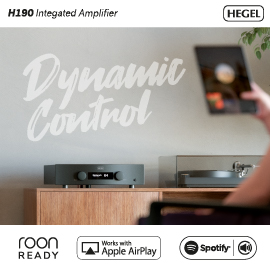 Karan Acoustics’ Master Collection LINEb is priced at $28,000 (all prices in USD), but it isn’t the most expensive preamplifier the company makes—that distinction belongs to the $41,000 Master Collection LINEa. But according to Doug Schneider in his April 15 review of the LINEb, anyone who is able to afford the LINEb will have purchased “one of the very best preamplifiers now available at any price.”
Karan Acoustics’ Master Collection LINEb is priced at $28,000 (all prices in USD), but it isn’t the most expensive preamplifier the company makes—that distinction belongs to the $41,000 Master Collection LINEa. But according to Doug Schneider in his April 15 review of the LINEb, anyone who is able to afford the LINEb will have purchased “one of the very best preamplifiers now available at any price.”
In his review, Doug described the LINEa and LINEb as “minimalist designs, with few features” that “let you select the input and adjust the volume, and that’s about it.” The main difference between the LINEa and LINEb is this: the LINEa’s power-supply circuitry has been split off into a separate case to reduce noise to even lower levels than the LINEb achieves, which, as shown in the LINEb measurements from our lab, is already extremely low. Therefore, the LINEa is a two-box component whereas the LINEb is in a single box.

Even with just one case, the LINEb’s dimensions of 19.8″W x 14.5″D x 5.1H″ (with feet) still mean that it’s big for a preamplifier—so big that Doug wrote: “it was the first preamp I’ve had here that was too wide to fit on a shelf of my equipment rack, which accepts components up to only 19″W.” He ended up having to move his turntable off the top shelf of his equipment rack and place the LINEb there.
Aside from the larger-than-normal size, the LINEb has features you’d expect, given its high price: build quality that Doug said “gives up nothing” to any brand, and bespoke circuitry inside the box. The LINEb offers 6dB of gain by default, but this can be changed internally to 9dB should the system it’s used in require it, and its volume control adjusts in 64 increments or decrements of 1dB (on the front panel display, the volume level ranges from 0 to 64).
The LINEb uses fully balanced circuitry from input to output, so while there are two sets of single-ended input connectors (RCA) alongside the four sets of balanced input connectors (XLR) on the LINEb’s rear panel, there are no single-ended outputs—only two sets of balanced output connectors (XLR). According to Karan Acoustics: “Our fully complementary design topology with smallest possible tolerances ensure the perfect balance between the positive and negative audio signal yielding absolutely identical amount of any distortion, noise or interferences that could arise on both signal polarities. Perfect balance of this kind mutually cancels all the unwanted signal by-products, leaving just the purest audio to reach our ears.”

To give a thorough assessment of the LINEb’s sound, Doug used it with multiple amplifiers: first was the Purifi Audio Eigentakt stereo amplifier, then with the Constellation Audio Revelation Taurus Mono monaural amplifiers, and finally with a pair of JE Audio VM60s, which are also mono amplifiers. The Purifi and Constellation amps are solid-state designs, while the VM60 mono uses tubes throughout.
From the first listen onward, Doug heard no colorations to the sound that he could attribute to the LINEb, which was a good thing; however, he also pointed this out: “But getting a preamp to neutrally reproduce sound from the lowest lows to the highest highs isn’t all that hard—plenty of preamps that cost less than the Karan can provide sound just as neutral.”

Doug felt that one of the LINEb’s main strengths was its high-resolution sound, with the resulting ability to “reproduce recordings with well-captured soundstages” exceptionally well. For example, he wrote the following about the reproduction of “Birmingham Shadows,” from Bruce Cockburn’s The Charity of Night (16-bit/44.1kHz WAV, True North), which features Cockburn’s vocals and guitar playing, with Gary Craig on drums and Rob Wasserman on double bass: “Each instrument and voice was not only exceptionally well defined in space and rock-solid in its position, but there was a sense of space and ‘air’ around each that I don’t recall having heard before with this recording.”
Doug then listened closely to the Cowboy Junkies’ The Caution Horses (16/44.1 WAV, RCA) and “heard the same precision of aural imaging, soundstaging, and spaciousness as previously unheard minute details sprang to life.” He also described how he became fixated on drummer Peter Timmins’s repeated rim shots in “’Cause Cheap Is How I Feel,” because of “just how woody was the sound of his stick striking the drum’s metal rim, and how precisely it was positioned on the stage: 5′ behind and 4′ to the left of lead singer Margo Timmins’s voice, at front center on the stage.”

Another LINEb strength that became obvious to Doug while using it with a range of power amps was its extremely low noise. When using it with Purifi’s Eigentakt, he noted: “When I turned the Karan’s volume knob all the way up to 64 with no music playing, then put one ear close to one Revel’s tweeter, I could hear only the tiniest hiss—on a par with what I hear from the Simaudio Moon Evolution 740P and EMM Labs Pre, which are extremely quiet preamps.” And with the Constellation Taurus mono amps he wrote that “with the volume at 64, no music playing, and an ear pressed to a tweeter,” the LINEb was as quiet as he’d ever heard. Doug thought that the JE Audio monos might bring out some noise because they have considerably higher gain than the Eigentakt and the Tauruses, which can exacerbate noise in the components feeding the amps, but again, there was no issue. He wrote: “With no music playing and with ear to tweeter, I heard no more noise than I’d heard with no preamp in the signal path.”
When his assessment of the LINEb was complete, it became clear to Doug that the LINEb could be used equally well with any of the amplifiers. He made this statement about the solid-state designs: “The Karan worked as well with the Constellations as it did with the Purifi—and that was very well indeed.” Three paragraphs on in the review, he highlighted how the preamp performed with the JE Audio monos: “As it had with the other amps, the LINEb proved to be a perfect partner for these tubed monoblocks.”

The only criticism that Doug could level at the LINEb was that its volume control works in 1dB steps—he would’ve preferred 0.5dB steps, for better fine-tuning of the volume. But when Doug pressed designer and owner Milan Karan on that issue, Karan responded that he felt it was “not necessary to make 0.5dB steps and complicate the attenuator with more components, because that would degrade the sound quality, and that is most important to me!”
Otherwise, Doug had “no criticism of the LINEb” and declared that it’s “of reference caliber.” So based on the strength of Doug’s review and the stellar test-bench results from our lab, we were left with no doubt that, in addition to the Reviewers’ Choice award that the LINEb was given when the review was published, this outstanding preamplifier also deserves to be recognized as one of our Recommended Reference Components.
Manufacturer contact information:
Karan Acoustics
Danila Kisa 5
21000 Novi Sad
Serbia
Phone: +381 63 507 729
E-mail: karan.acoustics@gmail.com
Website: www.karanacoustics.com






















